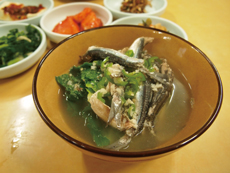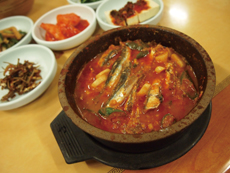
- Updated 2024.5.14 17:13
- All Articles
-
member
icon
-
facebook
cursor
-
twitter
cursor
|
TravelThings To Do |
Jeju traditional anchovy soup is worth the waitA review of Sikdorak Sikdang in Seogwipo |
|
When I first heard that the Sikdorak restaurant in Namwon, Seogwipo City, was famous for its Jeju traditional anchovy soup I called the owner to setup an interview. She said she was sorry but no, because of bad weather it was difficult to buy anchovies on the same day they were caught.
Could this be the reason that her restaurant has gained fame status? Supremely fresh anchovies? It was.
From that initial contact, I ended up calling the owner almost every other day to check if she was satisfied with the freshness of the anchovies brought to her kitchen that morning.
Finally, on my fourth attempt, I heard the magic words. “There’s anchovy soup today.” That very afternoon, I headed for Namwon.
| |
 |
|
| ▲ Anchovy soup Photos by Kim Jung Lim |
On the way to Sikdorak Sikdang, I tried to remember everything I knew about mel (Jeju dialect for the word anchovy). The 10-centimeter-long Jeju anchovy is bigger than those found elsewhere, and is loaded with calcium. With fresh mel, Jeju citizens make all sorts of dishes like guk (soup), jorim (an array of ingredients boiled with seasoning), jeotgal (salted fish), and twigim (a fried dish).
The restaurant, which originally specialized in Jeju fish okdom (tile fish) soup, has served mel soup every January to April for the past six years. The smiling owner Ko Hyang Soon, a Jeju native, said, “When I was young, my family frequently ate mel soup. From that [memory] I came up with an idea. Some customers wait for spring expecting to eat mel soup at my restaurant.”
| |
 |
|
| ▲ anchovies boiled with soybeans Photos by Kim Jung Lim |
Unexpectedly, before the interview began she showed me the process of making anchovy soup, and anchovy doenjang (soy bean paste) jorim. First, she put fresh anchovies in a pan of boiling water on the stove. After a moment, she added cabbage leaves by hand, saying, “To make the Jeju traditional taste of mel soup, we should use this kind of cabbage.” Then she added salt, garlic, and pepper. With common and simple ingredients she made a mouthwatering soup in five minutes.
As for jorim, the fish was seasoned with soy sauce, garlic, and pepper, and cooked in only 10 minutes in a small earthen pot. So, about 15 minutes after I got there, the two appetizing Jeju traditional foods were served to my table.
When I tasted the soup, I felt that the healthy food boosted my energy. The broth was tasty and somewhat sweet, even though no sugar was added. And chewing the whole headless fish wasn’t so unnerving. When I asked what was her secret, she said first it was the freshness of the fish, then her skill, and lastly by putting heart into the food. “If the fish is not fresh, no matter if the cook is professional, he cannot make good food,” she firmly added.
That’s Ko’s motto. Freshness. Since she started the restaurant in 1995, she tries to use anchovies on the same day they have been caught in either Hallim or Seogwipo City. “When there’s no mel in the morning due to high tide or typhoons in the ocean, we don’t get reservations.”
It’s the same story with their okdom. In addition to the seasonal anchovy soup, okdom soup is their main and most popular dish. Even though caught throughout the year, okdom from Jeju, especially from Seogwipo, costs a lot. However, according to Ko, the high quality of okdom boiled with radish makes for a refreshing, well-being meal. It is especially popular among those who want to cure a hangover.
The restaurant has regular customers — mainly City Hall employees. Recently, word-of-mouth has brought in more tourists to the place.
When it comes to Ko’s future plans for the restaurant, the owner said, “I want to develop the menu. Also, if I can make it, I hope to own my own restaurant to welcome my customers in a more clear place with a comfortable atmosphere.” (She is leasing the restaurant space now).
Like any other owner, the kind and warm Ko also has troubles like stress caused by compe-tition with other restaurants and the increasing price of fish. However, she finally said, “I really appreciate my customers for coming. I feel sorry when I’m too busy to do my utmost to serve them.” Her husband helping her added, “I’m happy when the people say ‘delicious!’ while eating. I will make an effort to continue to hear it.”
Now, if you want to taste this excellent Jeju traditional food at this sincere restaurant, check the weather forecast first. It is worth the wait.
|
Address: Taewi-ro, 689-gil, Seogwipo City (209-7 Namwon-ri, Namwon-eup)
Hours: 8 a.m. to 10 p.m. (Closed Sundays)
Telephone: 064-764-6004
|
|
|
|
|
|
|
|
|
ⓒ Jeju Weekly 2009 (http://www.jejuweekly.net)
All materials on this site are protected under the Korean Copyright Law and may not be reproduced, distributed, transmitted, displayed, published without the prior consent of Jeju Weekly. |
|
|
|
|
| Jeju-Asia's No.1 for Cruise |
|
|
|
Title:The jeju Weekly(제주위클리) | Mail to editor@jejuweekly.net | Phone: +82-64-724-7776 Fax: +82-64-724-7796
#503, 36-1, Seogwang-ro, Jeju-si, Jeju-do, Korea, 63148
Registration Number: Jeju, Ah01158(제주,아01158) | Date of Registration: November 10,2022 | Publisher&Editor : Hee Tak Ko | Youth policy: Hee Tak Ko
Copyright ⓒ 2009 All materials on this site are protected under the Korean Copyright Law and may not be reproduced, distributed, transmitted, displayed, published
without the prior consent of jeju weekly.com.

|





















